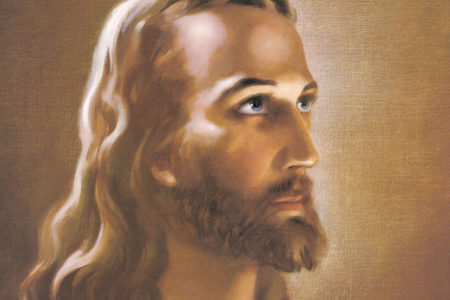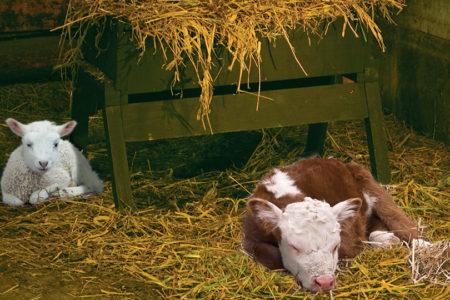Waiting for His Shout
It is not difficult to picture the scene Jesus’ disciples witnessed when the resurrected Lord ascended from the surface of the earth, rising higher and higher. Their squinting gaze no doubt focused on the clouds into which the Lord had vanished from their sight.
Yes, He had ascended into heaven; but a few moments earlier, He had given final instructions. As the disciples continued to stare into the sky, two angels scolded, “Men of Galilee, why do you stand gazing up into heaven? This same Jesus, who was taken up from you into heaven, will so come in like manner as you saw Him go into heaven” (Acts 1:11).
Embedded in the reproof was a message of hope that has brightened every Christmas season for centuries: Jesus is alive and is coming again.
Celebrating His final Passover with the disciples on the night He was betrayed, Jesus announced, “Where I am going you cannot follow Me now, but you shall follow Me afterward” (Jn. 13:36). Naturally, the disciples were distraught that He was leaving. They believed Jesus would usher in the Messianic Kingdom, which is why they had followed Him.
Jesus reassured them,
Let not your heart be troubled; you believe in God, believe also in Me. In My Father’s house are many mansions; if it were not so, I would have told you. I go to prepare a place for you. And if I go and prepare a place for you, I will come again and receive you to Myself; that where I am, there you may be also (14:1–3).
Jesus wasn’t simply leaving them; He was going to a specific place for a particular purpose with a definite plan to return. He described to His disciples a unique scenario that will culminate in a specific, identifiable event with clearly outlined details.
Using the imagery of a first-century Jewish wedding, Jesus not only conveyed the certainty of His return, but also the joy associated with it.
After paying a tribute to the bride’s family and establishing a marriage covenant with his future father-in-law, the bridegroom would return to his own father’s house to prepare a dwelling where he and his bride would reside.
Later, after finishing the residence and allowing time for his fiancée to prepare for married life, the bridegroom would lead a procession to her home, announcing his arrival with a shout. On hearing the bridegroom’s cry, the awaiting bride would go out to meet him, joining the procession to the marriage feast and their new home.
Jesus used the imagery of a wedding because His return for His church at the Rapture perfectly ts the picture of a Jewish bridegroom returning for his bride. The New Testament describes how Christ “loved the church and gave Himself for her…that He might present her to Himself a glorious church” (Eph. 5:25, 27).
Looking into the future, the apostle John saw the announcement of the Marriage Supper of the Lamb: “The Lamb [Christ] has come, and His wife has made herself ready…arrayed in fine linen, clean and bright” (Rev. 19:7–8).
The disciples who gathered in the upper room during Jesus’ final celebration of Passover became the first members of the New Testament church, also known as the bride of Christ.
Although the church as the bride did not fully enter the picture until the New Testament, Old Testament typology foreshadowed it. Bible scholar John Walvoord noted,
Some expositors have found, for instance, in the marriages of Isaac and Rebekah, Joseph and Asenath, Moses and Zipporah, and Boaz and Ruth a typical representation of the plan of God to present Christ with a bride, the church, composed largely of Gentiles. In each of these illustrations the bride is non-Jewish, that is, not a descendant of Jacob.1
Therefore, God’s plan was to form the church from all people of the world—Jewish and Gentile.
Jesus emphasized His purpose for going back to Heaven was to prepare a place for His bride, the church, in His Father’s house. The phrase and if I go and prepare a place for you conditionally links His departure with His return: “I will come again” (Jn. 14:3).
The Greek word translated “will come” is actually in the present tense (literally, “I am coming”) and “carries a future force . . . to emphasize the certainty of Jesus’ return for his disciples.”2
As in the ancient Jewish wedding ceremony, Christ’s return for His church at the Rapture is guaranteed:
- The apostle Paul told the Philippians, “For our citizenship is in heaven, from which we also eagerly wait for the Savior, the Lord Jesus Christ” (Phil. 3:20).
- James encouraged, “Be patient. Establish your hearts, for the coming of the Lord is at hand” (Jas. 5:8).
- The apostle John exhorted, “Abide in Him, that when He appears, we may have confidence and not be ashamed before Him at His coming” (1 Jn. 2:28).
Both Paul and John used the word we, expressing their confidence that Jesus Christ could return for His church at any moment.
It is evident Jesus’ words in John 14:3 speak of an exclusive event that defines the “blessed hope” of every born-again Christian (Ti. 2:13). The early church eagerly anticipated Christ’s return and greeted one another with the word maranatha, meaning “Our Lord, come.”
Throughout church history, born-again Christians have looked forward to meeting the Lord Jesus in the air. That moment is closer now than it has ever been. The Rapture is the next event on the prophetic calendar, and world events underscore its nearness.
As we celebrate the Lord’s First Coming this Christmas season, we can also rejoice that, at any moment, we may hear His shout, the voice of an archangel, and the trumpet of God announcing His return for His church.
ENDNOTES
- John Walvoord, “The Present Work of Christ—Part VII: The Present Work of Christ in Heaven (Part 5),” Theological Journal Library CD, posted with permission of Galaxy Software <www.walvoord.com/article/103>.
- Barclay M. Newman and Eugene A. Nida, A Translator’s Handbook on the Gospel of John (New York, NY: United Bible Societies, 1980), 456.








